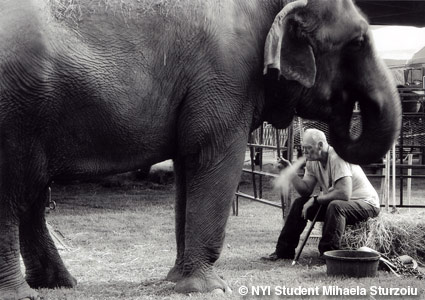Photo by online photography course Student Travis Belt

I like to dance, but largely confine my terpsichorean efforts to slow (very slow) waltzes in the style of Johann Strauss; Jr. — pieces like "The Blue Danube" or "Tales From the Vienna Woods". Or perhaps a saucy fox trot by Cole Porter such as "You're the Top" or "I've Got You under My Skin." Give me a couple of Macallan single malt whiskies under m'kilt and I may break out into a Highland Fling just like Cary Grant did in the movie "Indiscreet." But don't expect more!
Speaking of the movies, did you ever see "Death On the Nile," especially that scene where Peter Ustinov does a tango with a lovely young lady while David Niven also does a tango with a drunken Angela Lansbury? Well, I don't know how to tango much less flamenco dance with or without Angela Lansbury in my arms. I just don't know how to do it, regardless of how appealing I find all forms of Latin dance. So, when I discovered Travis Belt's photograph I knew that it would be fine for our Picture of the Month. Travis Belt is a NYIP Complete Course in Professional Photography student hailing from Dunn, North Carolina.
The senorita in swirling gown; the guitarists in the background (shades of Andres Segovia and Carlos Montoya); echoes of Blasco Ibanez; Garcia Lorca; and Ortega y Gasset; the castanets clicking; the heels tapping; Carmen the Cigarette Girl! ¡Olé! Consider that the Three NYIP Guidelines have been well observed by Travis Belt, the photographer.
First, the frame has been very well filled — an easy was to simplify the picture and your third NYIP Guideline. Some might object to the presence of the spotlight in the upper left, but I don't. This is a theatrical performance, and stage lighting such as that spotlight helps to convey the theatricality of the scene. In other words, the spotlight helps to focus attention on the subject (your second NYIP Guideline).
Now look at the lines. There are four kinds — vertical lines, horizontal lines, diagonal lines, and lines formed as part of the arc of a circle. Each kind of line has its symbolism. A vertical line suggests strength, power, majesty. It is important that the dancer maintain a vertical line from the top of her head to the dance floor. That is her center, so to speak. All the other swirls and twirls emanate from that vertical line, hence the absolute necessity for the dancer to maintain that line (almost like a flag pole). The horizontal lines can be seen in the position of the guitar's neck on the right. And that horizontal line intersects the vertical line at a right angle. Horizontal lines suggest a certain tranquility or serenity. The other two guitar necks are more diagonal in nature as are the dancer's upper arm and the angle of her swirling gown. With diagonal lines comes the sense of danger and excitement and throbbing passion — all characteristic of tango. Let us not overlook the curves. A curved line is female in nature, often suggesting the tender way a young mother embraces her infant child. We see here the shape of the senorita's face, the arch of her back, the swell of her bosom, the flaring curve of her buttocks. If these four kinds of lines meet at approximately the same point in the photograph there is tremendous tension and vitality shown. The eye is quickly drawn to that point or points, and it is hard to divert one's attention to anything else.
Strong subject matter? Witness the stance, the speed, the inherent drama the dancer gives us. This is not the Girl Next Door, you know, that Judy that you took to the senior prom in high school! By the way, I went to an Argentine steak house over the Christmas holidays. There was a small dance floor there, and instructions were being given in the Art of the Tango. I tried my clumsy 1940 jitterbugging and was hooted off the dance floor. I suspect my Flamenco number would have failed as well!






